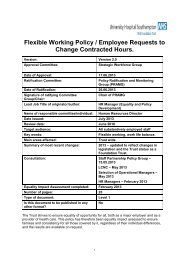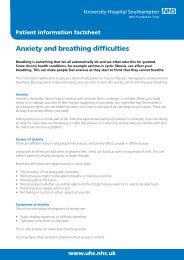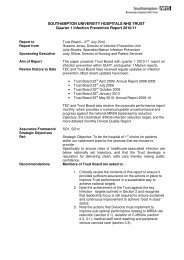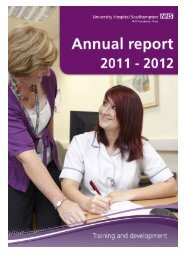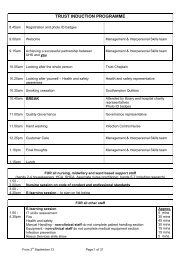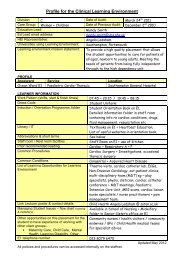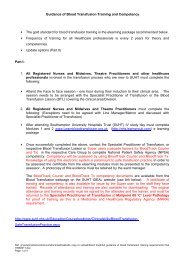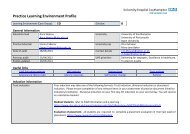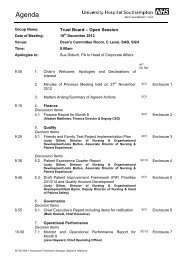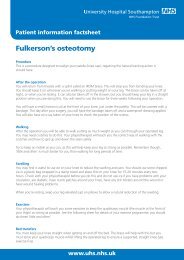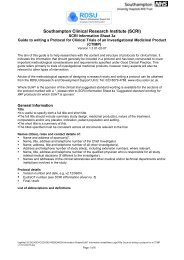Checking that your baby is well - patient information
Checking that your baby is well - patient information
Checking that your baby is well - patient information
Create successful ePaper yourself
Turn your PDF publications into a flip-book with our unique Google optimized e-Paper software.
<strong>Checking</strong> <strong>that</strong> <strong>your</strong> <strong>baby</strong> <strong>is</strong> <strong>well</strong>A guide to <strong>your</strong> <strong>baby</strong>’s first two weeksHappy Not sure UnhappyTemperature: Try putting the back of <strong>your</strong>hand on <strong>your</strong> <strong>baby</strong>’s tummy, th<strong>is</strong> will tell youif they are hot or cold.Muscle tone and activity: In the early days<strong>your</strong> <strong>baby</strong> might have some involuntarymovements. It <strong>is</strong> common for them to sneeze,stretch and hiccup.Colour and jaundice: Some babies maybecome yellow and th<strong>is</strong> can be a sign of acondition called jaundice. About 50% ofnewborn babies can develop jaundice.Eyes: It <strong>is</strong> normal for babies to have poorcontrol over their eyes and appear cross eyedat times. Eyes look grey – blue, or brown incolour. They will develop their eye colourfrom six to12 months.Mouth: If <strong>your</strong> <strong>baby</strong>’s mouth <strong>is</strong> mo<strong>is</strong>t it meanshe/she <strong>is</strong> feeding <strong>well</strong>. You might even noticea bl<strong>is</strong>ter on their top lip, th<strong>is</strong> <strong>is</strong> normal.Your <strong>baby</strong> should feel warm to touch.They will be able to grasp <strong>your</strong>hand and will enjoy touching andstroking.Your <strong>baby</strong> should be a normal skintone. Babies may have hands andfeet <strong>that</strong> are blue for about 24 to48 hours after birth.Your <strong>baby</strong> can have a smallamount of d<strong>is</strong>charge from theireyes. Th<strong>is</strong> <strong>is</strong> normal and needs tobe cleaned with cool boiled waterand cotton wool.A white tongue <strong>is</strong> normal aftera feed.If <strong>your</strong> <strong>baby</strong> feels hot or cold tryadding or removing a layer ofclothes or blankets.Seek immediate advice from <strong>your</strong>doctor if <strong>your</strong> <strong>baby</strong> feels hot afteryou have removed some layers ORIf <strong>your</strong> <strong>baby</strong> <strong>is</strong> pers<strong>is</strong>tently cold,they may be un<strong>well</strong>.Your <strong>baby</strong> should never be floppy or stiff. They might be un<strong>well</strong> if theyd<strong>is</strong>like being cuddled and do not like bright lights. Call a doctor if th<strong>is</strong>applies to <strong>your</strong> <strong>baby</strong>.If <strong>your</strong> <strong>baby</strong> <strong>is</strong> yellow but wakingfor feeds, feeding <strong>well</strong> and havingwet and dirty nappies contact <strong>your</strong>midwifery team who will monitor<strong>your</strong> <strong>baby</strong> closely.If there <strong>is</strong> a lot of d<strong>is</strong>charge clean<strong>your</strong> <strong>baby</strong>’s eyes regularly andcontact <strong>your</strong> midwifery team.If you see white spots in <strong>your</strong> <strong>baby</strong>’smouth which do not d<strong>is</strong>appearin between feeds, contact <strong>your</strong>midwife or GP.Call a midwife if <strong>your</strong> <strong>baby</strong> <strong>is</strong>n’tfeeding <strong>well</strong>, <strong>is</strong> floppy, sleepy andnot having wet and dirty nappies.They will need to assess <strong>your</strong> <strong>baby</strong>today.If <strong>your</strong> <strong>baby</strong>’s eyes look red andswollen call <strong>your</strong> doctor. Th<strong>is</strong> couldbe a sign of infection.If the mouth <strong>is</strong> dry and <strong>your</strong> <strong>baby</strong><strong>is</strong>n’t feeding <strong>well</strong>. Call a midwifestraight away.www.uhs.nhs.uk
Happy Not sure UnhappyFeeding: The frequency with which <strong>your</strong> <strong>baby</strong>feeds changes over time, please d<strong>is</strong>cuss th<strong>is</strong> with<strong>your</strong> midwife. If you are breastfeeding, pleaserefer to <strong>your</strong> breastfeeding diary, as th<strong>is</strong> will giveyou a day by day guide to feeding <strong>your</strong> <strong>baby</strong>.Wet and dirty nappies: The contents of <strong>your</strong><strong>baby</strong>’s nappy changes from day to day in thebeginning. You should expect:• Day one to four: Baby’s nappies are usuallyblack/green in colour. It can look like thicktar or marmite!• Day four to seven: Your <strong>baby</strong>’s nappies willstart to change colour from black/green toyellow.• Day seven onwards. A <strong>baby</strong>’s nappy will beyellow. It will be soft and seedy if you arebreastfeeding or look like play dough if <strong>your</strong><strong>baby</strong> <strong>is</strong> formula fed.Cord: The umbilical cord will start to dry outand will usually fall off by the time <strong>your</strong> <strong>baby</strong><strong>is</strong> two weeks old. The cord needs cleaningwith cool boiled water and drying afterwards.Dry Skin: It <strong>is</strong> normal for <strong>your</strong> <strong>baby</strong> to havedry skin.A <strong>well</strong> fed <strong>baby</strong> will be contentduring and after a feed and havewet and dirty nappies.Babies will normally have severalwet nappies a day.Some <strong>baby</strong> girls can have a smallbleed or a d<strong>is</strong>charge from theirvagina.You may even notice a yellowor dark orange urine stain in thenappy. Th<strong>is</strong> <strong>is</strong> normal.The cord can be sticky underneath,th<strong>is</strong> <strong>is</strong> normal.Wash <strong>your</strong> <strong>baby</strong> with water. Avoidusing cleansing products.If you have any feeding concerns call <strong>your</strong> postnatal co-ordinator who willcontact <strong>your</strong> midwifery team or v<strong>is</strong>it a breastfeeding support group today.If you are worried <strong>that</strong> <strong>your</strong> <strong>baby</strong>has not passed much urine (wee)you should feed them frequently.Put a little cotton wool in theirnappy and you will know if theyhave passed urine.There may be a spot of blood whenthe cord falls off. Th<strong>is</strong> <strong>is</strong> normal.Let the midwife know today if theyhaven’t passed much urine.Your <strong>baby</strong> may be constipated ifthey are struggling to poo. Inform<strong>your</strong> midwife or health v<strong>is</strong>itor forfurther advice.If you notice a red ring around thetummy button let a doctor knowstraight away.If <strong>your</strong> <strong>baby</strong>’s skin <strong>is</strong> very dry ask <strong>your</strong> midwifery team for advice at <strong>your</strong>next appointment.SouthamptonNew ForestPostnatal midwifery co-ordinator (8.30am to 4.30pm) 07786 266529 Postnatal midwifery co-ordinator (8.30am to 4.30pm) 023 8074 7693Broadlands Birth Centre (out of hours) 023 8120 6012 New Forest Birth Centre (out of hours) 023 8074 7690If you need a translation of th<strong>is</strong> document, an interpreter or a version in large print, Braille or onaudio tape, please telephone 023 8120 4688 for help.Rev<strong>is</strong>ed August 2013 Review date August 2016. PAH001.01www.uhs.nhs.uk



